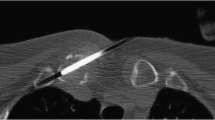Abstract
Aim
Clavicle is a unique bone for many reasons. There is no study discussing the differential diagnosis of clavicular lesions based on the site of occurrence or age at presentation. This study aims to determine whether the distribution of lesions affecting the clavicle and age at presentation aid in the differential diagnosis of focal clavicular lesions.
Materials and methods
Clinical notes, imaging and histopathological reports of the clavicular lesions between Jan 1999 and Jan 2006 were reviewed. Virtually, all patients had been referred as suspected neoplasm.
Results
Fifty-nine patients were identified. Patients <20 years (n = 27) had non-neoplastic or benign lesions. Patients between 20–50 years (n = 14) had predominantly non-neoplastic lesions. Patients >50 years (n = 18) had predominantly malignant lesions. The lesions most commonly affected the medial third (n = 35) and were predominantly non-neoplastic or benign. The middle third was affected in 15 patients and showed both benign and malignant lesions. The lateral third was least affected with predominance of malignant lesions.
Conclusions
The clavicle is not a primary common site for any particular tumour; hence, diagnosis of the lesions can be challenging. Our study has suggested that few factors like age and site of the lesions may be helpful in diagnosis.












Similar content being viewed by others
References
Kumar R, Madewell JE, Swischuk LE, Lindell MM, David R. The clavicle: normal and abnormal. Radiographics 1989; 9 4: 677–706, Jul.
Giedion A, Holthusen W, Masel LF, Vischer D. Subacute and chronic “symmetrical” osteomyelitis. Ann Radiol (Paris) 1972; 15 3: 329–342, Mar–Apr.
Kasperczyk A, Freyschmidt J. Pustulotic arthroosteitis: spectrum of bone lesions with palmoplantar pustulosis. Radiology 1994; 191: 207.
Chamot AM, Benhamou CL, Kahn MF, Beraneck L, Kaplan G, Prost A. Acne-pustulosis-hyperostosis–osteitis syndrome. Results of a national survey. 85 cases. Rev Rhum Mal Osteoartic 1987; 54 3: 187–196, Mar.
Beretta-Piccoli BC, Sauvain MJ, Gal I, et al. Synovitis, acne, pustulosis, hyperostosis, osteitis (SAPHO) syndrome in childhood: a report of ten cases and review of the literature. Eur J Pediatr 2000; 159 8: 594–601, Aug.
Schuster T, Bielek J, Dietz HG, Belohradsky BH. Chronic recurrent multifocal osteomyelitis (CRMO). Eur J Pediatr Surg 1996; 6 1: 45–51.
Sundaram M, McDonald D, Engel E, Rotman M, Siegfried EC. Chronic recurrent multifocal osteomyelitis: an evolving clinical and radiological spectrum. Skelet Radiol 1996; 25 4: 333–336, May.
Bjorksten B, Boquist L. Histopathological aspects of chronic recurrent multifocal osteomyelitis. J Bone Joint Surg Br 1980; 62 3: 376–380, Aug.
Hummell DS, Anderson SJ, Wright PF, Cassell GH, Waites KB. Chronic recurrent multifocal osteomyelitis: are mycoplasmas involved. N Engl J Med 1987; 317 8: 510–511.
Manson D, Wilmot DM, King S, Laxer RM. Physeal involvement in chronic recurrent multifocal osteomyelitis. Pediatr Radiol 1989; 20 1–2: 76–79.
Kozlowski K, Masel J, Harbison S, Yu J. Multifocal chronic osteomyelitis of unknown etiology. Report of five cases. Pediatr Radiol 1983; 13 3: 130–136.
Toussirot E, Dupond JL, Wendling D. Spondylodiscitis in SAPHO syndrome. A series of eight cases. Ann Rheum Dis 1997; 56 1: 52–58, Jan.
Smith J, Yuppa F, Watson RC. Primary tumors and tumor-like lesions of the clavicle. Skelet Radiol 1988; 17 4: 235–246.
Thai DM, Kitagawa Y, Choong PFM. Outcome of surgical management of bony metastases to the humerus and shoulder girdle: a retrospective analysis of 93 patients. Int Semin Surg Oncol 2006; 1 3: 5, Mar.
Brower AC, Sweet DE, Keats TE. Condensing osteitis of the clavicle: a new entity. AJR 1974; 121 1: 17–21, May.
Greenspan A, Gerscovich E, Szabo RM, Matthews JG 2nd. Condensing osteitis of the clavicle: a rare but frequently misdiagnosed condition. AJR Am J Roentgenol 1991; 156 5: 1011–1015, May.
Kruger GD, Rock MG, Munro TG. Condensing osteitis of the clavicle. A review of the literature and report of three cases. J Bone Joint Surg Am 1987; 69 4: 550–557, Apr.
Fanquet T, et al. Condensing osteitis of the clavicle. Report of two new cases. Skelet Radiol 1985; 14 3: 184–187.
Outwater E, Oates E. Condensing osteitis of the clavicle: case report and review of the literature. J Nucl Med 1988; 29 6: 1122–1125, Jun.
Author information
Authors and Affiliations
Corresponding author
Rights and permissions
About this article
Cite this article
Suresh, S., Saifuddin, A. Unveiling the ‘unique bone’: a study of the distribution of focal clavicular lesions. Skeletal Radiol 37, 749–756 (2008). https://doi.org/10.1007/s00256-008-0507-7
Received:
Revised:
Accepted:
Published:
Issue Date:
DOI: https://doi.org/10.1007/s00256-008-0507-7




